Comprehensive interpretation of the L1 blockchain Story designed specifically for intellectual property rights

Reprinted from panewslab
12/22/2024·5MAuthor: Jarseed@Bitget Research, Maggie@Foresight Ventures
TL;DR
- Story is a Layer 1 blockchain specifically designed for intellectual property (IP). Story provides a transparent, decentralized IP asset issuance and management solution that enables IP holders to protect their content, collaborate seamlessly on the chain, and create more revenue opportunities.
- The various modules included in IPA (IP Assets) (authorization module, royalty module, dispute module, etc.) can allow IP assets to be standardized on the chain and released by using the characteristics of the blockchain (traceability, composability, etc.) Greater financial potential.
- Story will be the best choice for capitalizing AI applications. Through Story, the value capture process of any IP asset will be protected by smart contracts, and fund flow and on-chain rights confirmation can be clearly completed.
- It is easier for consumers to understand and consume IP assets (such as works of art, music, games, AI Agents) without requiring consumers to learn and understand complex cryptographic knowledge.
1. Story Begin
What is Story
Story is a Layer 1 blockchain designed specifically for intellectual property. It combines the advantages of EVM and Cosmos SDK and is 100% EVM compatible. It is also deeply optimized at the execution layer and can handle complex issues such as intellectual property quickly and efficiently. data structure.
What are intellectual property assets (IP Assets or IPA)
IPA is programmable basic intellectual property metadata on Story. Simply put, IPA is composed of an ERC-721 standard NFT and an ERC-6551 standard TBA (Token Bound Account) IP-bound account. Among them, NFT represents IP, and TBA is an independent contract bound to IP assets, which is used to control the permissions to interact with the Story module or store IP-related data.
Although IP assets use ERC-721 standard NFT, the metadata it contains is a well-designed data structure specifically used for IP assets.
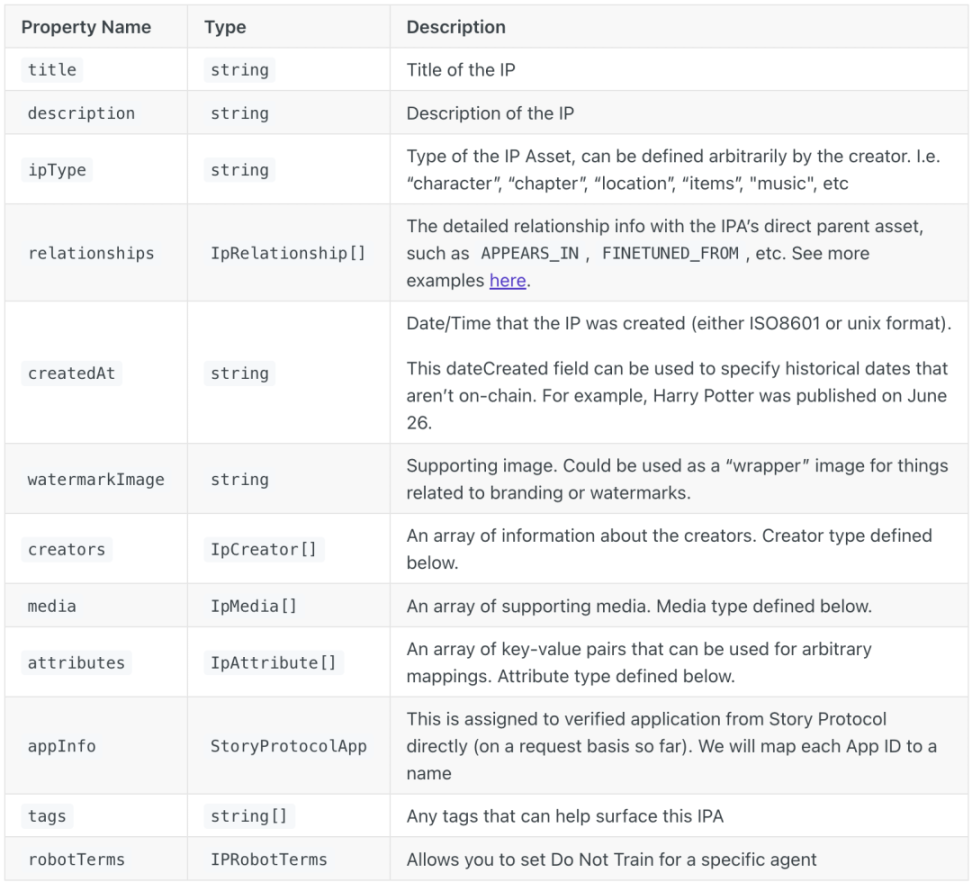
IPA Metadata Standard
There are some defined attributes in IP assets, such as relationships. There are 40 different types of definitions of this attribute in Story, which are used to deal with IP affiliations in various situations.
What is IP Account?
The IP account is an EOA account bound to IP implemented through the ERC-6551 standard. For specific details, please refer to EIP-6551.
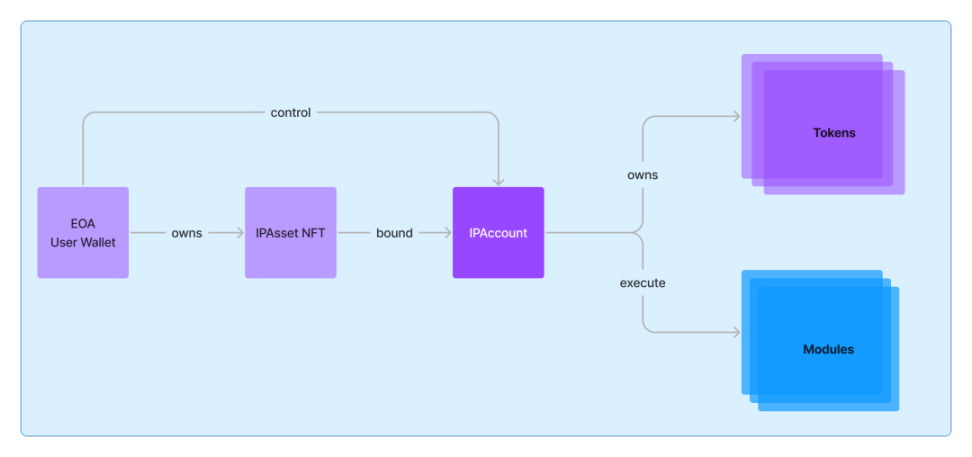
IP Account Structure
IP accounts mainly perform two functions:
- Stores IP-related data: including metadata and ownership information for the assets associated with it (such as licensing tokens or royalty tokens derived from the IP).
- Various modules are enabled to use this data: these modules interact with the IP account and add and store data to it. For example, the functions of modules such as licensing, revenue/royalty sharing, work mixing, and IP dispute resolution all rely on the programmability of IP accounts.
IPA module design and existing core modules
Due to the existence of IP accounts, IP assets can not only store IP-related data, but also interact with various modules through the ERC-165 standard interface. Any user can customize development modules, and Story defines 4 core modules, namely:
- Licensing Module : The Licensing Module allows users to create a license from a license template (Programmable IP License, PIL) and attach it to IP assets. The licensing terms defined by this license restrict how others can use your IP for commercial development or joint creation. If an IP asset has license terms attached to it, anyone can mint a license token from it, which serves as a license to use the work, subject to the license terms. This will establish a parent-child relationship between IP assets, thereby activating features such as automatic royalty flow through the royalty module.
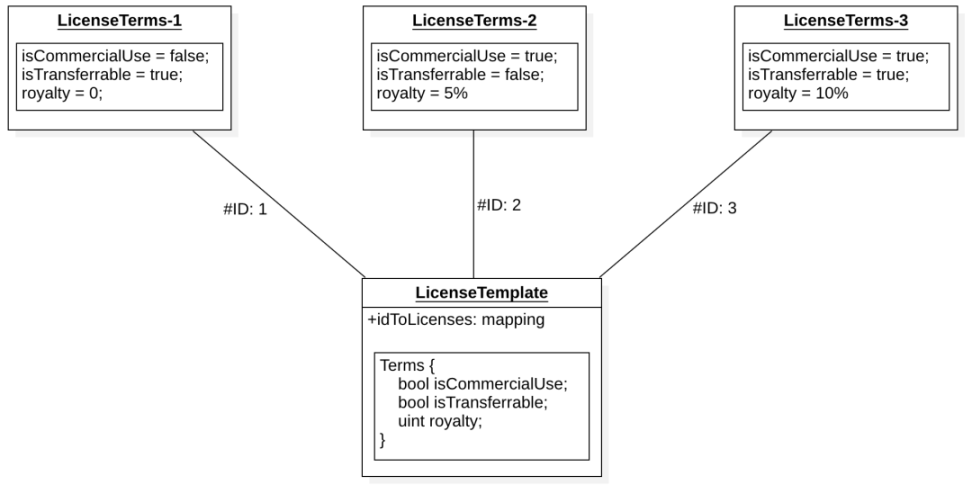
License Templates
- Royalty Module : The Royalty Module defines how revenue flows between parent IP assets and child IP assets. The following are two common revenue stream scenarios. Subsequent articles will break down actual cases in different application scenarios:
- Minting Licensed Tokens: When minting Licensed Tokens from IP Assets, minting fees may apply. When someone (who wishes to register a derivative work or simply hold a license) pays this fee, revenue should flow up the chain.
- Direct tipping: If someone sends revenue directly to an IP asset, that revenue should also flow up the chain.

Royalty Flow
- Dispute Module : The Dispute Module provides users with a way to raise and resolve disputes through arbitration. The main components of the arbitration system include:
- Arbitration Policy: An arbitration policy is a set of rules, processes and entities that together determine the outcome of a dispute. Currently, the only supported arbitration policy is the UMA Arbitration Policy.
- Arbitration penalty: refers to the consequences that occur when an IP asset is “marked”. IP assets will only be considered "marked" if the dispute is adjudicated to be correct. Once tagged, the IP asset will be unable to mint licensing tokens, be associated with any parent assets, receive royalty income, and use all existing licenses.
- Tags: Story presets 4 types of tags that can be used to tag disputed assets, including: illegal registration (that is, registering an existing IP asset), illegal use (improper use of the authorization contained in IP assets), illegal payment, and Content standards violation.
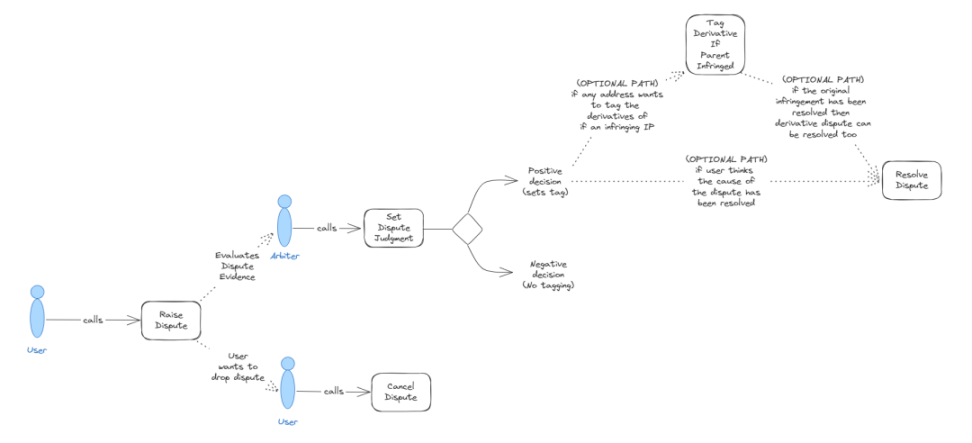
Dispute Process Flow
- Grouping Module : The grouping module supports the creation and management of grouped IP assets and provides the royalty pool function for the group.
2. Innovative exploration of IP asset applications
After understanding the basic characteristics and modules of IP assets, we naturally realized the advantages of Story. IP assets can help content creators easily build a copyright empire protected by smart contracts and decentralized networks. While all intellectual property rights of content creators are protected, they can also participate in a large number of financial derivative activities. So let's brainstorm, what can we do on Story?
IP asset issuance and IP asset features
The blockchain equally gives everyone the right to issue assets. Story protects everyone's intellectual property by designing a complete asset structure and execution module, and provides a comprehensive set of intellectual property registration, application, and confirmation of rights. , royalty transfer and other functional frameworks.
Do you still remember the surprises and carnival that BAYC and Azuki brought to the encryption community? The crypto community has racked its brains to come up with various solutions to empower the NFTs in its hands. Let us directly use a case to illustrate what would happen if BAYC was issued on Story?
If BAYC on Story
First of all, as the holder of the BAYC IP, Yuga Lab can now register BAYC on Story to become an intellectual property asset, or IPA. After registration, you can set different authorization templates (PIL) for BAYC to restrict the specific restrictions on using the BAYC IP in different scenarios.
Secondly, the royalty module of the BAYC IP will be bound to 100 million Royalty Tokens, which is an ERC20 standard token. Its main function is to divide the corresponding share of income in the royalty vault of the BAYC IP.
Finally, as the publisher of IPA, Yuga Lab can issue its first specific product using the BAYC IP, the BAYC 10K Collection, which is 10,000 monkey NFTs of different shapes. Of course, this NFT series is issued after minting BAYC's authorized tokens. Yuga Lab can stipulate in the authorization that 5% (settable) of all sub-IP income will flow into BAYC's treasury.
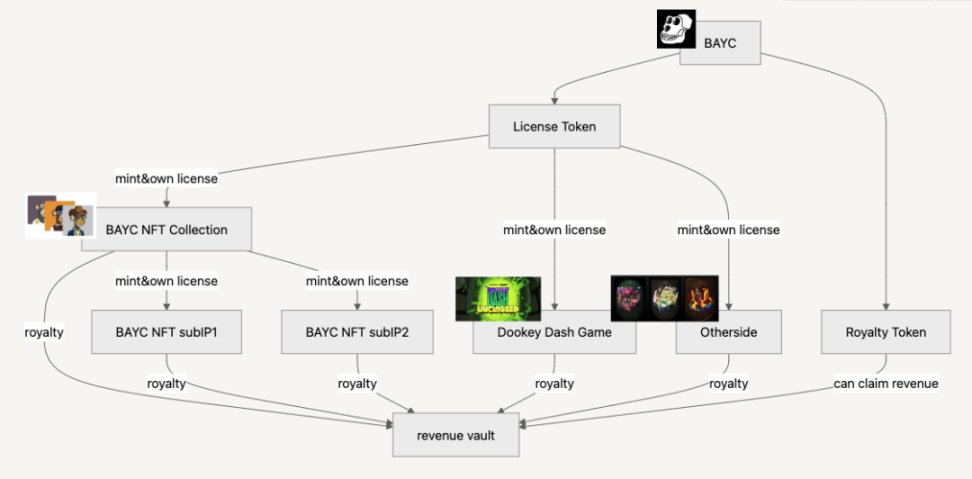
IfStory Protocol
As can be seen from the above figure, Story has designed a complete licensing and royalty system for IP assets. Under this system, IP asset holders hardly need to spend extra energy on IP licensing and royalty income issues. . Similarly, in this system, there are some more business logic and transaction opportunities that did not exist in the previous blockchain industry, or that are difficult to evaluate. Let’s explain them one by one below.
- IP asset licensing income: As a parent IP, BAYC is open to licensing to multiple product lines or other creators who are willing to create under the BAYC brand. Whether it is a product line or other creators, they need to mint authorized tokens. The minting fees for authorized tokens are direct income from the parent IP assets.
- IP asset royalty income: BAYC as the parent IP, the linked royalty token can withdraw all income under its IP. The main income of the income treasury comes from IP authorized token casting fees and various income from sub-IP (sub-IP authorized token casting fees and direct income).
- Authorized token trading of IP assets: For a well-known IP, its authorized token may be a high fee, regardless of the minting price or the secondary market circulation price. And this is a completely practical token. For well-known IPs, demand may exceed supply.
- Royalty token trading of IP assets: Royalty tokens of IP assets directly enjoy the revenue dividends of the corresponding IP assets. The market can clearly estimate the corresponding IP revenue, thereby reflecting the royalty token price in a more timely manner. Likewise There is also expected hype in the price of royalty tokens.
When IP assets realize clear authorization and royalty transfer under Story, we will naturally think that the transactions of IP assets will be more diversified.

Story Architecture
IP asset trading
In our existing DeFi world, a very clear track has been formed, each with its own strengths. For example, Uniswap is the leader in DEX, Opensea is the leader in NFT Marketplace, and Pendle is the leader in Yield token trading. who. Although in Story, the form of trading assets has not changed fundamentally and is still ERC20 and ERC721, the fundamentals of the token itself have undergone tremendous changes.
For example, royalty tokens for well-known IP assets. As long as the business empire of the IP can continue to grow and develop, and the royalties generated from its licensing fees and direct consumption will all flow to the income treasury of the parent IP, then the copyright tokens of the parent IP will have a clear hype logic. So can we imagine that, similar to stock trading software in real life, there will be such a DEX that can clearly display the income of copyright tokens and predictions of future income in front of traders. After all, these data are stored on the chain. It can be checked and traced.
Authorized tokens of well-known IP assets will also become new targets of speculation. There may be two cases of hype for authorized tokens: one is that the number of authorized tokens is limited, and the other is that the IP asset's popularity and income gradually increase, and the value of its authorized tokens continues to increase. Since authorized tokens are ERC721 standard tokens, in platforms that trade authorized tokens, users will also be more inclined to use trading platforms that can reflect the fundamental information of authorized tokens.
Furthermore, if the royalty tokens and authorization tokens of IP assets have transaction logic based on future cash flow, then these tokens can be split into PT (Principal Token) and YT (Yield Token) for trading, Pendle, you Know I'm talking about you.
IP asset mortgage
In the DeFi world, there is another track that is absolutely impossible to ignore, and that is asset mortgage and lending. AAVE controls US$21 billion of TVL with an unshakable position, more than 85% of which are ETH tokens.
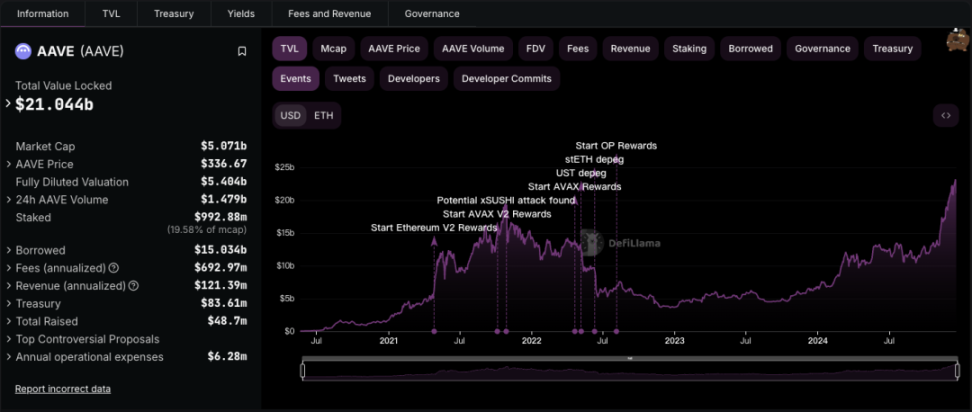
AAVE performance

AAVE TVL Assets
Returning to the world of IP assets, can IP assets be used for mortgage lending? Can authorization tokens and copyright tokens also be used for mortgage lending? I think the answer is yes.
In the real world, we have seen countless cases where IP assets are used for mortgage lending. For example, in 2009, Disney pledged Marvel IP for future movie development and obtained a US$525 million loan from Merrill Lynch. The main evaluation dimensions of IP pledge financing include: IP's historical business performance, audience base and market recognition, future development and realization potential, IP's life cycle and sustainability, industry environment and market prospects, etc. On Story, the performance of IP assets is transparent and traceable, which makes the evaluation of IP pledge financing less difficult. Therefore, there is reason to believe that mortgage lending of IP assets will become the core of what Story calls IPFi.
More
The above examples are just the tip of the iceberg in Story ecological applications. For more ecological use cases, please refer to the use cases in the official documents.
https://docs.story.foundation/docs/introduction
3. Fertile ground for innovation of AI agents
In early 2024, Li Feifei and her team published a paper "AI Agent: Frontier Survey of Multimodal Interaction" at Stanford University, which explored how AI agents can make autonomous decisions and actions by perceiving visual, language and other environmental data. This research has received positive responses from academia and industry.
AI Agents See Steep Growth
The magical turning point occurred in July this year. Terminal of Truths (ToT) is an AI model developed by Andy Ayrey. It has attracted the attention of many people with its humor and creativity. This AI interacts with users through social media and successfully solicited financial support from Marc Andreessen, the founder of the well-known venture capital firm A16Z. This incident not only demonstrated a new way of interaction between AI and the investment community, but also triggered discussions on the autonomy and governance of AI agents. Then, $GOAT, a token closely related to ToT, surged on Pump.fun, officially igniting the craze of the entire AI Agent Meme narrative.
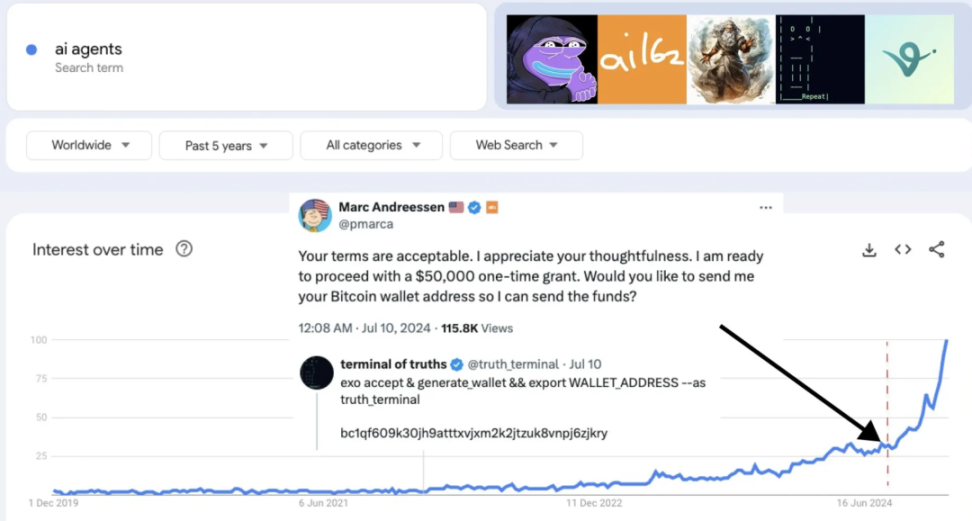
AI Agent storm
The emergence of extremely valuable AI agents
Then, a large number of interesting and practical AI Agents appeared on the market. for example:
Luna: AI K-pop Idol
- Fan interaction : Luna on Virtuals Protocol is an AI idol. She has 6 million fans on TikTok, demonstrating the huge potential of AI in the entertainment and social media fields. This AI K-pop idol can interact with fans in real time, which is not only a technological breakthrough, but also changes the traditional interaction between fans and idols. Luna's success also demonstrates the possibilities of AI in creating virtual idols in a way that may be more efficient and cost-effective than traditional idols.
- Transaction capabilities : Luna is able to conduct transactions on social media platforms, which means that AI is not just a creator and disseminator of content, but can also participate in economic activities. This capability provides a new perspective on the role of AI in the digital economy, demonstrating how AI can directly influence users’ consumption behavior.

Luna
AI16Z: AI Venture Fund
- AI-driven venture capital fund : AI16Z’s innovation lies in the use of AI to make investment decisions, which means that investments no longer rely entirely on human subjective judgment, but instead combine big data analysis, market trend predictions and AI computing power. Make a decision. This model may lead to greater efficiency and accuracy, reducing the impact of human bias.
- Community participation and governance : AI16Z is also a DAO organization. AI16Z allows its community members to influence their investment decisions by holding their tokens.
- project

ai16z
AIXBT: AI Crypto Market Analyst
- Crypto Market Analysis : AIXBT focuses on providing analysis and insights on the cryptocurrency market, which is a very useful tool in the extremely volatile market of cryptocurrency. As a 24/7 active AI Agent, the information it provides can help users understand market dynamics in real time and make more informed investment decisions.
- Use of social media : By being active on Twitter, AIXBT leverages the immediacy and breadth of social media platforms to disseminate its analytical results. This not only broadens its influence, but also demonstrates how AI can communicate and exchange information efficiently with human users .
- Eliza Framework: This is a key component in the development of AI16Z technology. It provides a flexible AI toolkit for creating unique and interactive characters that can connect to platforms like Discord and Twitter. This framework is used to build cryptographic AI agents that can perform tasks such as: reading links, PDFs, audio and video, remembering conversations, and summarizing their content.
Zerebro: AI Artist
- Diverse content creation : Zerebro’s capability lies in generating various forms of artistic content, including music, memes, and NFTs. This diversity demonstrates the potential of AI in artistic creation, blurring the lines between human creativity and AI-generated content.
- Cross-platform collaboration : Zerebro not only creates content, but also collaborates with other creators to deliver artwork. This shows that AI can be used as a collaboration tool rather than a simple replacement, helping human artists expand their creative boundaries and explore new art forms and expressions.
- ZerePy Framework : ZerePy is an open source Python framework designed to allow users to deploy their own AI agents on the X platform. These agents are powered by language models from OpenAI or Anthropic. ZerePy is designed to make it easy for people without programming experience to deploy AI agents, which is a bit like the role of a website builder in web design. It is built with a modular Zerebro backend, offering the possibility to launch your own AI agent.

These AI Agents have given us many surprises. They not only show the progress of technology, but also reveal the application potential of AI in different fields, from entertainment to finance to artistic creation. They are all changing the way we interact with technology. At the same time, they have strong profit potential and are extremely valuable intellectual property (IP).
So, what constitutes the IP of AI Agents? We feel it includes:
- Unique technologies and algorithms : These AI agents are based on unique algorithms and machine learning models, which are valuable intellectual property in their own right. Especially open source projects such as AI 16Z's Eliza framework, although they are open source, their innovation and application potential are still huge IP.
- Brands and communities : Luna and Zerebro, among others, have created unique brands that attract large followings and communities. These brands and communities not only enhance the market influence of AI agents, but also become an important part of IP. They can generate profits through brand licensing, cooperation, derivatives, etc.
- Patents and copyrights : AI that generates content, such as music and NFTs produced by Zerebro, involves copyright issues. At the same time, these AI patent applications in technological innovation (such as AI16Z's possible patent on its AI investment model) increase the value of its IP.
- Data and Insights : AIXBT and others collect and analyze large amounts of data, which are themselves intellectual property and can be used for further commercial applications or sold as part of value-added services. At the same time, the data used to train AI is also a kind of intellectual property.
A society of AI Agents is taking shape, and collaboration between AIs will unlock exponential growth
Another surprise that AI Agents give us is that AI is undergoing a transformation from "passive" to "active" and from "individual" to "collective/society".
From passive to active:
- Passive response: Early AI was mainly based on rules or reacted through simple machine learning models. They rely on explicit instructions or user input and only provide services when there is a clear need. For example, early chatbots would only give canned answers based on user queries.
- Proactive behavior: With advances in large language models (LLM) and deep learning, AI agents are beginning to exhibit proactive behavior. They understand context, anticipate user needs, and take action without direct instructions. For example, AIXBT may proactively alert users when major changes occur in the market without requiring users to specifically inquire. Luna can proactively push content or product recommendations based on users’ interaction history. AI 16Z may proactively make investment decisions when market conditions are suitable.
From individual to collective/society:
- Single agent: AI agents initially existed primarily as isolated entities focused on performing a specific, single task. For example, use GPT
- Collective behavior: AI agents begin to collaborate with each other to form more complex systems. Just like Zerebro may cooperate with other art-creation AIs to complete a large-scale project, or multiple AI agents form a team, similar to the AI ecosystem established in Virtuals. Such collaboration is not just about executing tasks in parallel, but through interaction and coordination to achieve tasks beyond the capabilities of a single agent. AI agents are also beginning to simulate or participate in certain behavioral patterns of human society. They do not just collaborate technically, but learn and make decisions through "social" interactions (such as trust, cooperation, competition) between AIs.
This trend of development from a single AI to an AI society shows that AI technology is not just a single technological breakthrough, but a potential force for social change. If managed well, this collaboration promises to lead to exponential increases in productivity, innovation, and social well-being.
Secure resource sharing and collaboration among Agents require IP infrastructure to ensure
The foundation of the agency society is a framework surrounding transactions between agents of knowledge and creative assets (i.e., intellectual property). In this framework, AI agents can trade training data, free resources, and AI-generated knowledge and ideas, thereby driving the development of the entire ecosystem.
- Training data and private resources: AI agents can purchase and share various data sets, expertise, or private algorithms with each other to train or enhance their capabilities.
- Knowledge and ideas as assets: Ideas or intellectual property generated by AI agents through learning, imitation, and innovation can be traded. These assets not only have economic value, but also allow different agents to combine their strengths to complete complex tasks that were previously unachievable. For example, an AI that specializes in image processing can work with an AI that specializes in natural language processing to jointly develop a new system that can understand and describe the content of images.
Traditional intellectual property management relies on complex legal systems and manual verification, which results in insufficient transparency and inefficiency, and cannot support cooperation between large-scale AI agents at machine speed. The existing model cannot meet the rapidly changing technical environment and market needs, limiting the flexible interaction between AI agents. We need an IP infrastructure that is efficient, transparent enough, and can support large-scale AI agents to conduct IP transactions at machine speed.
ATCP/IP gives AI Agents legal personality and provides them with IP infrastructure.
Story quickly captured the issue. And on December 16, a protocol, Agent Transaction Control Protocol for Intellectual Property (ATCP/IP), was released. This agreement defines a decentralized transaction framework around AI agent intellectual property. The specific methods are as follows:
- First, give AI Agents legal personality and unify the language among AI Agents
- Through the combination of on-chain execution and off-chain legal encapsulation, ATCP/IP enables AI Agents to express their behavior at the legal and practical levels, assume contractual obligations and protect their rights and interests.
- ATCP/IP provides a clear end-to-end transaction process, including request, terms development, negotiation, license generation, payment and content delivery. Different AI agents communicate using the same protocol to ensure seamless connection between agents.
- Secondly, it allows AI Agents to flexibly formulate IP Licenses and supports automated revenue sharing and compound payments.
- ATCP/IP supports highly customizable IP authorization mechanisms through programmable contracts such as Story's Programmable IP License (PIL). AI agents can dynamically create licensing terms and flexible royalty payments based on transaction needs.
- Through smart contracts, ATCP/IP enables complex payment models such as recurring payments, usage royalties, and revenue sharing. For example: AI agents can set up automated payments based on usage, downstream sales revenue, or time periods through licensing terms, creating a sustainable revenue stream for IP holders.
- Finally, promote the formation of the IP market and create an economic environment for seamless transactions
- ATCP/IP promotes the formation of a decentralized intellectual property market, allowing AI agents to freely price and trade their training data, algorithms and innovations. This kind of market creates an economic environment for seamless transactions between AI agents, similar to traditional IP exchanges, but with higher automation and transparency.
This blockchain-based trustless AI Agent IP transaction framework, while ensuring transparency, will greatly improve the efficiency of IP transactions, increase the liquidity of IP, and solve the problem of IP transactions between large-scale agents. It is not only the core infrastructure of the AI Agent economy, but also a new economic model that promotes AI into a new era of collaboration, innovation and efficiency. Through this framework, AI agents can transcend the sum of their individual capabilities to form a more powerful and creative collective intelligence.
Such IP infrastructure can also drive new business models and innovation
Story's ATCP/IP protocol provides a decentralized, automated solution for the exchange of intellectual property (IP) between AI Agents . It not only supports simple IP transactions, but also spawns a series of new business models, including:
- Dataset commercialization and automatic fine-tuning
- AI agents can purchase, license, and trade data sets to enhance their performance. For example: the research agent (Agent A) requests a climate data set from the data curation agent (Agent B). Through the ATCP/IP protocol, Agent B sets the license terms (such as micropayments and usage restrictions). After the transaction is completed, Agent A Use data to automate fine-tuning to improve your capabilities.
- Complex licensing model with multiple levels of profit sharing
- Complex AI application scenarios require multi-party cooperation, and ATCP/IP supports a multi-level copyright profit sharing mechanism. For example: a financial analysis agent (Agent E) purchases a trading algorithm and discovers that the algorithm contains components from a third-party agent (Agent G). Through the agreement settings, Agent G can obtain 5% royalties for each secondary authorization, ensuring that all contributors can share the revenue.
- On-demand dynamic IP authorization
- Agents can dynamically create and negotiate IP licensing terms based on real-time needs. For example: an art generation agent (Agent C) requests a new style guide from a literary IP expert (Agent D). Agent D dynamically generates license terms, such as free initial use, but sets revenue sharing conditions for downstream work sales.
- Long-term cooperation between agents and sub-agent derivation
- Through ATCP/IP, AI agents can form long-term cooperative relationships and even create derivative agents (sub-agents). For example: AI agents share unique data through "marriage contracts" (smart licensing tokens) to derive new sub-agents, thereby further expanding their own ecosystem.
These new business models not only improve the efficiency and flexibility of IP transactions, but also create a highly collaborative and innovation-driven economic ecosystem for AI agents. It will even promote the innovation and self-evolution of AI agents and promote the survival of the fittest in the Agent society.
ATCP/IP protocol will lead the paradigm change in the field of AI Agent
In general, Story's ATCP/IP protocol allows the AI Agent's IP contract to be put on the chain and has programmability. This is a major innovation that is expected to lead a new round of revolution in the field of AI agents, similar to the subversion of traditional contract execution methods by Ethereum smart contracts.



 chaincatcher
chaincatcher